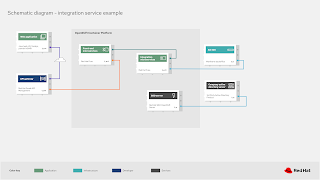 |
| Part 9 - Example service integration |
It started with laying out the process of how I've approached the use case by researching successful customer portfolio solutions as the basis for a generic architecture.
Let's continue looking at more specific examples of how these architectures solve specific integration use cases.
This article walks you through an example integration scenario showing how expanding the previously discussed details provides guidance for your own integration scenarios.
Architecture scenario
As mentioned before, the architectural details covered here are base on real customer integration solutions using open source technologies. The example scenario presented here is a generic common architecture that was uncovered researching customer solutions. It's my intent to provide an architecture that provides guidance and not deep technical details.
This section covers the visual representations as presented, but it's expected that they'll be evolving visually over time. There are many ways to represent each element in this architecture, but I've chosen icons, text and colours that I hope are going to make it all easy to absorb. Feel free to post comments at the bottom of this post, or contact me directly with your feedback.
This section covers the visual representations as presented, but it's expected that they'll be evolving visually over time. There are many ways to represent each element in this architecture, but I've chosen icons, text and colours that I hope are going to make it all easy to absorb. Feel free to post comments at the bottom of this post, or contact me directly with your feedback.
Service integration
The example architecture shown in the figure titled Example: Integration Service Use outlines how to integrate microservices in to your architecture. In this example, starting from the top, an online application is used to connect to your services through an API gateway. It's leveraging a group of microservices that provide frontend functionality. These frontend microservices are gathering data and information from the various organizational backend systems by working through integration microservices. The showcased backend system in this example case is a mainframe.
While there is no direct link between the various internal microservices to security services, it's implied by showing the authentication and authorization services supported through Single Sign On (SSO) server. This SSO server is leveraging existing organizational choices that involve using a third party active directory solution. It's crucial to understand that SSO functionality is pervasive throughout the integration use cases, so consider it included as plugins for every service artifact in the architecture.
There is a conscience effort here to keep this example as concise as possible, therefore the integration of various potential backend systems has been simplified to a single representative box.
Third party service integration
 While the above architecture shows service integration within your own organization using open technologies, what about legacy third party service implementations?
While the above architecture shows service integration within your own organization using open technologies, what about legacy third party service implementations?
While there is no direct link between the various internal microservices to security services, it's implied by showing the authentication and authorization services supported through Single Sign On (SSO) server. This SSO server is leveraging existing organizational choices that involve using a third party active directory solution. It's crucial to understand that SSO functionality is pervasive throughout the integration use cases, so consider it included as plugins for every service artifact in the architecture.
There is a conscience effort here to keep this example as concise as possible, therefore the integration of various potential backend systems has been simplified to a single representative box.
Third party service integration
 While the above architecture shows service integration within your own organization using open technologies, what about legacy third party service implementations?
While the above architecture shows service integration within your own organization using open technologies, what about legacy third party service implementations?
Many organizations are forced to live, at least for the time being, with legacy choices and have service integrations that need to tie in existing technology platforms. With open technologies like Red Hat Fuse, it's like having a universal tool for connecting to almost any technology.
The example architecture shown in the figure titled Example: Integration To Third Party Service Use outlines how to integrate your organization with third party services in your architecture. In this example, starting from the top, an online application is used to connect to your services through an API gateway. It's leveraging a group of microservices that provide frontend functionality. These frontend microservices are gathering data and information from the various organizational backend systems by working through integration microservices.
The showcased backend system in this example case are a set of security services that have been implemented on a third party platform using proprietary technology. Have no fear, you can enable the services they provide in place by fronting them with a set of integration microservices. This enables your development organization to deliver agile and flexible applications without having to rip and replace large parts of your existing architecture.
What's next
This overview covers the first example architecture for the omnichannel customer experience use case.
- An introduction
- Generic common architectural elements
- External application details
- API management details
- Container platform essentials
- Storage services
- Example process integration
- Example mobile integration
- Example service integration
We've now finished this series, so if you missed any of the articles please head back and read them following the links above. This tour of our architecture for omnichannel customer experience should help you in designing, planning, and executing on your own unified customer experience.
